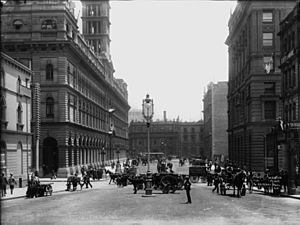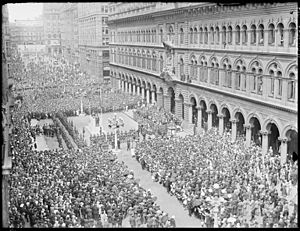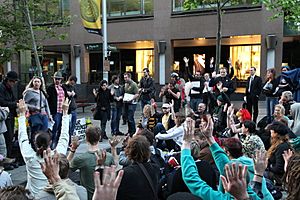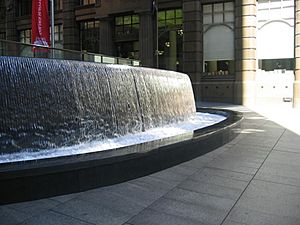Martin Place facts for kids

View from Castlereagh Street
|
|
| Other name(s) | 'The heart of the City' 'The hub of the City' |
|---|---|
| Former name(s) | Moore Street |
| Part of | Sydney central business district |
| Namesake | Sir James Martin |
| Type | Pedestrian zone |
| Owner | City of Sydney |
| Length | 473 m (1,552 ft) |
| Location | Sydney, New South Wales, Australia |
| Postal code | 2000 |
| Nearest metro station | Martin Place railway station Martin Place metro station (projected opening 2024) |
| From | Macquarie Street (east) |
| Major junctions |
Phillip Street Elizabeth Street Castlereagh Street Pitt Street |
| To | George Street (west) |
| Construction | |
| Construction start | 1890 |
| Completion | 1935 |
| Inauguration | 1892 |
| Other | |
| Known for | Sydney Cenotaph Reserve Bank of Australia General Post Office 2014 Sydney hostage crisis |
Martin Place is a famous pedestrian area in the heart of Sydney, New South Wales, Australia. It's often called the "civic heart" of Sydney because many important events and gatherings happen here. It's also a major business and finance hub, home to big banks like the Reserve Bank of Australia and the Commonwealth Bank. The historic Sydney GPO is also located here.
Martin Place is well-known in Australia for being a popular spot for filming movies and TV shows. It stretches between George Street and Macquarie Street. You can also find entrances to the Martin Place railway station underground. Other streets that cross Martin Place include Pitt Street, Castlereagh Street, Elizabeth Street and Phillip Street.
The first part of Martin Place, between George Street and Pitt Street, officially opened in 1892. It was named after Sir James Martin, who was a Premier of New South Wales (like a state leader) three times and a Chief Justice (a top judge). Starting in 1971, the street was gradually closed to cars, becoming the pedestrian area you see today. It's surrounded by many old, beautiful buildings and features the Sydney Cenotaph from 1927, a water fountain, and places to sit and relax.
Contents
History of Martin Place
Martin Place wasn't always the wide, open space it is today. It was built in different stages. Before the late 1800s, only the section between Pitt Street and Castlereagh Street existed, and it was called Moore Street. The area between Pitt Street and George Street was just a small laneway, like a narrow alley.
In 1863, construction began on the General Post Office Building on the south side of this laneway. The building was designed to have its main entrance facing the longer north side. This led to plans to make the narrow laneway wider and connect it to Moore Street. A fire that destroyed buildings nearby helped speed up this plan. So, in 1892, the widened street was officially opened and named "Martin Place." It was named after James Martin, a former leader and chief judge of New South Wales. The General Post Office took up the entire south side of the new street.
Both Moore Street and Martin Place quickly became important places for business and banking in Sydney. In 1913, the main office of the Commonwealth Bank was built at the corner of Moore Street and Pitt Street. Other banks soon followed, building impressive offices. In 1921, Moore Street was officially renamed as part of Martin Place, making it one long street.
Important events happened here, like rallies during World War I to encourage people to join the army. In 1927, the Sydney Cenotaph was built to remember those who died in World War I. Soon after, there were plans to extend the street further east towards Macquarie Street. This plan faced some delays because buildings had to be knocked down. One church, St Stephen's Presbyterian Church, was moved to a new location to make way for the extension. The extension was finally finished in 1935, creating the Martin Place we know today, stretching from George Street to Macquarie Street.
Martin Place became known as the "heart" or "town square" of Sydney. Because of this, people wanted it to be a pedestrian-only area, free from cars. This change happened gradually from 1971 to 1979, when the whole street became a pedestrian mall. During this time, some old buildings were saved from being demolished thanks to community efforts. The street was closed to traffic partly to allow for the building of the Martin Place railway station underground. The station opened in 1979.
In May 1980, Queen Elizabeth II and Prince Philip, Duke of Edinburgh visited Martin Place during their royal tour. Some older buildings were replaced with modern ones during this time, like 25 Martin Place, designed by famous architect Harry Seidler.
Architecture of Martin Place
Martin Place is home to many buildings with different styles, from classic old designs to very modern ones.
Famous Buildings in Martin Place
| Address | Building name | Image | What it's like | Interesting Facts |
|---|---|---|---|---|
| No. 1 | General Post Office, Sydney |  |
This building is at the western end of Martin Place. It has a grand sandstone front with columns. | Built between 1866 and 1891, it was the main post office for New South Wales. Today, it has shops, cafes, and a hotel. |
| No. 2 | Bank of Australasia Building |  |
This building is on the corner of George Street and Martin Place. It has a unique Federation Romanesque style. | It was saved from being knocked down in the 1970s. It's now used for shops. |
| No. 4–10 | Challis House |  |
This building was completed in 1907. It has an Art Deco style. | It belongs to the University of Sydney and was named after John Henry Challis, who left a lot of money to the university. |
| No. 5 | Commonwealth Trading Bank Building (old headquarters) |  |
This 12-story building was built in 1916. It was Australia's first large steel-framed "skyscraper." | It was the main office for the Commonwealth Bank and is nicknamed the "Money Box Building" because it was shown on money boxes given to children. |
| No. 9 | 25 Martin Place (formerly MLC Centre) | 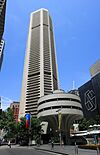 |
This 228-meter tall skyscraper is shaped like an octagon. | When it opened in 1977, it was the tallest reinforced concrete office building in the world outside North America. The Consulate of the United States of America is here. |
| No. 38–46 | MLC Building |  |
This 11-story Art Deco building is on the corner of Castlereagh Street. | It used to be the main office for a big finance company called MLC. You can still see the large red "MLC" letters on its clocktower. |
| No. 48 | State Savings Bank Building |  |
This building has a special pink granite and terracotta front. | It opened in 1928 as the main office for the Government Savings Bank of NSW. Its main hall was one of the largest in the world. |
| No. 53–63 | Australian Provincial Assurance building |  |
This 14-story Art Deco building is on the corner of Elizabeth Street. | It used to be the Overseas Union Bank. Today, it has a Lindt chocolate store and cafe. |
| 52 | Colonial Building |  |
This modern building has a dark glass front and a 36-story tower. | For many years, the Seven Network's news and morning TV shows like Sunrise were filmed here. |
| No. 65 | Reserve Bank of Australia Building | 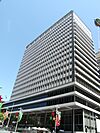 |
This building is between Phillip and Macquarie Streets. | It's the main office for the Reserve Bank of Australia, which is Australia's central bank. It also has a money museum. |
| No. 60 | (former Westpac Building) | This building is between Phillip Street and Macquarie Street. | It was finished in 2019 and has floors that stick out over the historic St Stephen's Uniting Church. |
Buildings Nearby
- At the Macquarie Street end, you'll find the Sydney Hospital.
- At the George Street end, there's the old Westpac building and the Commercial Banking Company of Sydney Limited building, which now has a Burberry store.
- On Elizabeth Street, the Sun Building used to be the office for The Sun newspaper. This tall, Gothic-style building is one of only three like it in Sydney.
Other Interesting Features
- Sydney Cenotaph: This monument is located between the GPO Building and Challis House. It remembers Australian soldiers who fought in World War I and other wars. It was built in 1927.
- A water fountain: You'll find a water fountain on the east side of Pitt Street. Behind it is an amphitheatre, which is a stage that can be raised for performances.
- Underground entrances: There are entrances to the railway station and a plaza below the street.
- Commando Memorial: This memorial is in the middle of Martin Place, near the eastern end. It honors Australian commandos who died in World War II.
Heritage Listings
Several buildings in Martin Place are listed as heritage sites, meaning they are protected because of their historical or architectural importance:
- 1 Martin Place: General Post Office, Sydney
- 4–10 Martin Place: Challis House
- 38–46 Martin Place: MLC Building
- 53–63 Martin Place: Australian Provincial Assurance Building
- 65 Martin Place: Reserve Bank of Australia Building
Transport in Martin Place

George Street, Elizabeth Street, and Castlereagh Street, which cross Martin Place, are all major routes for buses in Sydney's city center. The Martin Place railway station is located underground, right beneath the mall. Other nearby train stations include St James railway station (near Macquarie Street) and Wynyard railway station (near George Street).
A new Sydney Metro train line will also have a station underneath the existing Martin Place station. It is expected to open in 2024.
Events in Martin Place
Martin Place has become the "civic heart" of Sydney, a place where people gather for important events. In the past, because the General Post Office and its telegraph office were here, it was where important news first arrived. People would gather here to hear or celebrate big news. This is why the cenotaph was placed here after World War I. Martin Place is now the main place for Sydney's official war remembrance ceremonies.
The street's extensions made it an even more important public space, connecting George Street (the old main shopping street) with Macquarie Street (where government buildings are). People still gather here today for many reasons, like watching live broadcasts on a big screen during the 2000 Summer Olympics or for important national apologies. The amphitheatre near Pitt Street often hosts music, cultural events, and even peaceful protests.
Regular Events in Martin Place
- Sydney Festival: Martin Place is a major site for the opening night of this annual festival in early January.
- Anzac Day Dawn Service: Every year on April 25th, a special service is held at the Cenotaph to remember soldiers.
- Vivid Sydney: In late May to early June, you can see amazing visual art displays here during this festival.
- Outdoor concerts: Music events are held in the amphitheatre throughout the year.
- Christmas tree: Sydney's largest Christmas tree stands in Martin Place every November and December. A concert is held when the tree lights are first turned on.
Past Events in Martin Place
- In 1901, a large arch was built to celebrate the Federation of Australia (when Australia became a nation).
- In 1954, Queen Elizabeth II and Prince Philip drove through Martin Place during their first visit to Australia.
- The pedestrian area of Martin Place was officially opened in stages between 1971 and 1979.
- During the Sydney 2000 Summer Olympics, Martin Place was an outdoor venue with large TV screens showing live coverage.
- The Occupy Sydney protest movement set up a camp in Martin Place in 2011, staying for several months to raise awareness about social issues.
- In 2012, a protest related to an anti-Islam film took place in Martin Place.
- In December 2014, Martin Place was placed into lock-down due to a serious incident at the Lindt Café. People gathered in the area to show support and mourn.
- A group of homeless people set up a "Tent City" in the mall from December 2016 to August 2017.
Martin Place in Movies and TV
Martin Place has been featured in several famous movies and TV shows:
Movies
- The Matrix trilogy: The Lloyd Rees fountain near Pitt Street was seen in The Matrix (1999). Martin Place was also the setting for a big fight scene in The Matrix Revolutions.
- Superman Returns (2006): Superman saves someone from a car accident in scenes filmed here.
Television
- Seven Network Studios: For 19 years, the studios for popular Australian TV shows like Seven News, Sunrise, and The Morning Show were located in Martin Place. These shows moved in 2023.
- Rake: This ABC TV series about a lawyer is set in Martin Place.
- The Mole: The 2005 season of this reality TV show filmed live elimination rounds in the Seven Network studios in Martin Place.
- The Amazing Race: Martin Place was part of a challenge in the second season of this American reality TV series.


